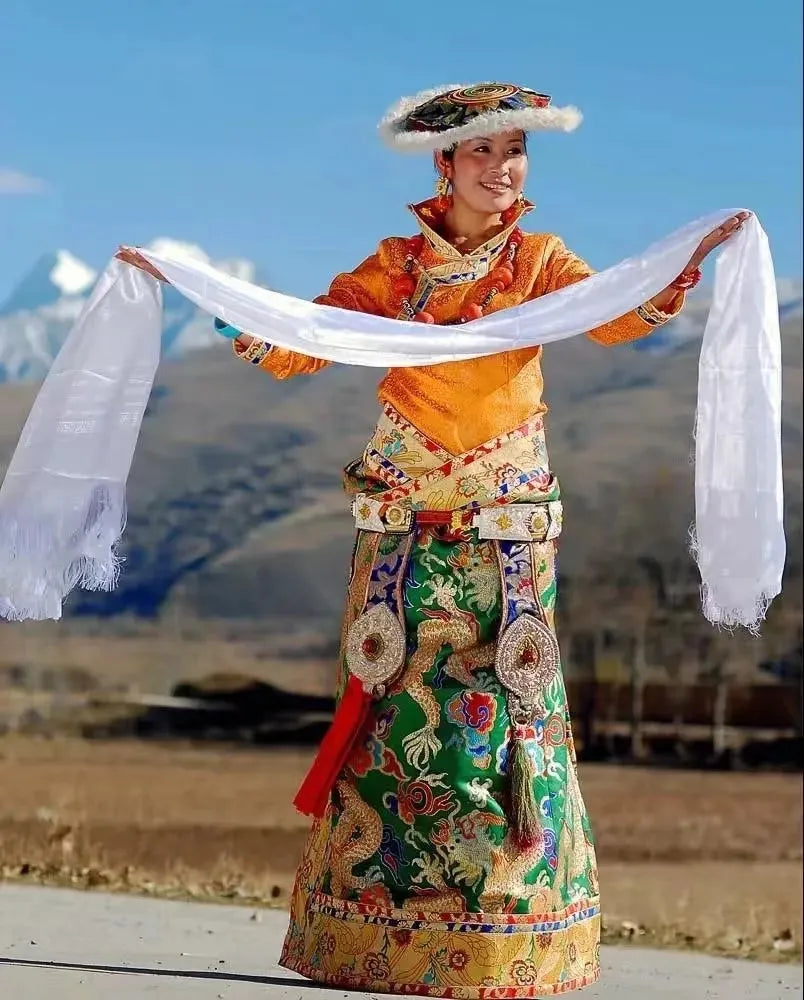
Snowy White Mountains, Tribute to Hada
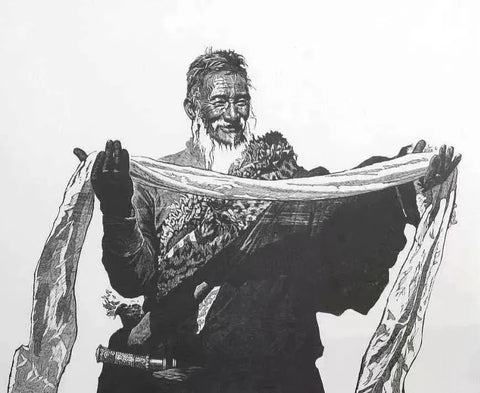
The etymology of the word "hada"

Image source: Internet
For the word "hada", different dictionaries have different explanations.
For example, in the Monlam Dictionary, khata is written as ཁ་དར། and phonetically translated as "hada ri", with the explanation "a silk fabric widely used among Tibetan and Mongolian people as a ceremonial gift to express blessings or to welcome honored guests".
On the other hand, the Dongkar Dictionary states: "There is no clear explanation of the term 'hada' in Tibetan historical books, but it has been passed down orally by the older generation. Long ago, when a respected guest visited a family or a family member was about to embark on a journey, elders would knead a small lump of tsampa into a white dot and stick it on the collar, symbolizing blessings for the guest and a safe return for the family member. After the Mongolian rule in Tibetan regions, they changed it to using blue or yellow silk fabrics draped around the neck, or holding it in hand to show blessings, naming it hadaཁ་བཏགས།."

Image source: Internet
Origin and spread
So, what is the origin of hada? The Tibetan people have always valued the color white, which symbolizes purity, auspiciousness, sincerity, kindness, justice, and prosperity. The tradition of revering white has been long-standing among the Tibetan people, with white stones placed on sacred mountains as a symbol of blessings, white stones placed on mani stone piles, and white wool tied to long arrows on the "Labtse" (stone pile erected with stones and soil stones in Tibetan areas, with long bamboo poles, long arrows, and long spears inserted on top, and prayer flags hung on them) to show reverence to the deities.
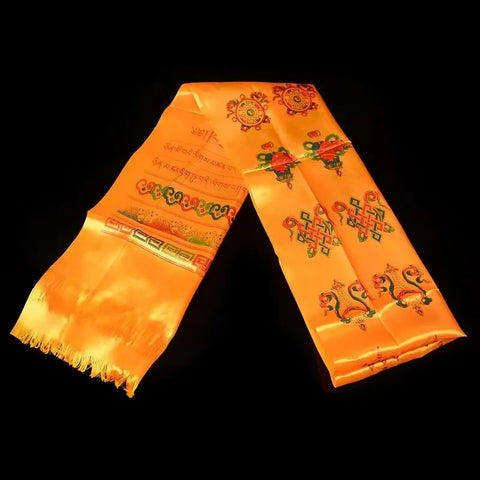
Image source: Internet
In the "Record of Gadan Disciples' Inquiries", it is recorded that in the 11th century, when Zhong Dunba invited the venerable Atisha to Tibet to preach and transmit the teachings, he also respectfully presented a silk ribbon with auspicious meanings. However, at that time, there was no specific term for "khata". From this, it can be inferred that although there was no specific term for "khata" at that time, the custom of presenting silk ribbons existed. In addition, in other related documents, it is recorded that during the Yuan Dynasty in 1265, when the Dharma King Butiba returned to Tibet for the first time after meeting Emperor Kublai Khan, when Butiba presented a khata to the Jokhang Temple deity, a mural of a mother goddess reached out her hand and asked for a khata. This mother goddess was then referred to as "Zhuo Ma Da Ling Ma" (the mother goddess who asks for khata), and from then on, the term "khata" was officially recorded in historical books and became known to the world. The tradition of presenting silk had been replaced by high-quality silk-had khata.
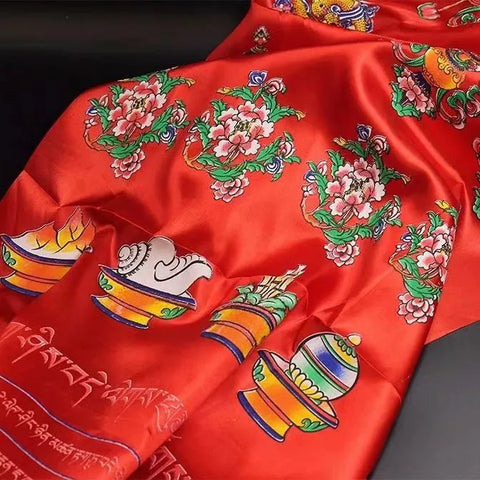
Image source: Internet
In the "Dongga Dictionary" written by Dongga Losang Chikle, it is recorded that "Hada" was used during the Yuan Dynasty when the Mongolian ruled over Tibetan areas, and it was changed to a blue or yellow silk fabric tied around the neck or held in hand as a blessing, and from then on it was named Hada. Additionally, in the "Origins of the Tibetan Buddhist Tradition," it is recorded that "when Master Tsongkhapa paid homage to his teacher and practiced the Kalachakra, he offered white, yellow, and blue Hadas to his teacher. Later, as Tibetan Buddhism became more popular, Mongolian and Tibetan people who believed in Tibetan Buddhism also adopted the ceremonial culture of offering Hada.
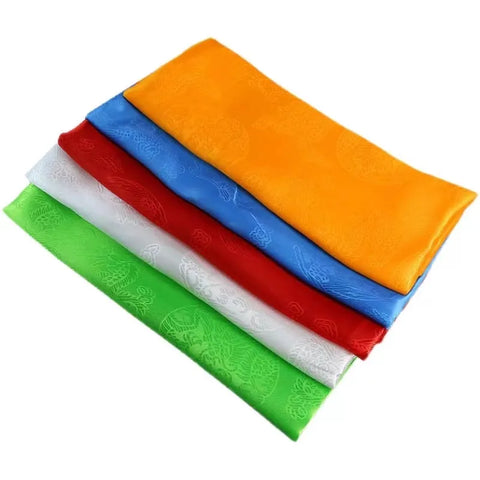
Image source: Internet
In the current Tibetan language textbooks for the fifth grade in five provinces and autonomous regions, there is a text written by Tsaidan Doje titled "The Origin of the hada." In the text, it is mentioned that the tradition of offering hada originated in Tibetan areas. During the reign of the ninth generation Tibetan king Buton Gongjie of the Tubo Kingdom, the Bonpo follower Watao Jian wrapped sheep wool around his head during religious rituals. From this, it can be inferred that the use of hada in Tibetan areas dates back to a very early time. The earliest hada was referring to wrapping sheep wool around a treasure vase or bottle mouth (in Tibetan, hadaཁ་བཏགས། ཁ is the mouth, and བཏགས is the wrapping or tying), shortened to hadaཁ་བཏགས། for rhythmic harmony.

Image source: Internet
With the development of society, commerce gradually flourished, and fabrics and silk fabrics from the Central Plains of China and India gradually poured into Tibet. The fabrics from the Central Plains and white silk fabrics were not only beautiful but also practical, gradually replacing the wool of Tibet. This led to the custom of presenting a piece of fabric or silk ribbon as an offering, and later on, the length and width were standardized. From then on, they were collectively referred to as khatas, and according to their quality, they were further divided into different types such as inner Tibet hada, outer Tibet hada, auspicious hada, fortune hada, victory hada, and plain hada.

Image source: Internet
In the book "Hada and Tibetan Customs" by historian Kan Ben, it is mentioned that "Hada" refers to silk or satin, used as a ceremonial ribbon. It is a form of respect and is similar to the ancient Han custom of presenting silk as a gift. In terms of usage, influenced by the prevalence of Tibetan Buddhism, Hada is widely circulated in the Himalayan region, Inner Mongolia, Mongolia, and other regions. In addition, Hada can also be seen in Han Buddhist temples and sacred sites in mainland China.
Categories and Meanings
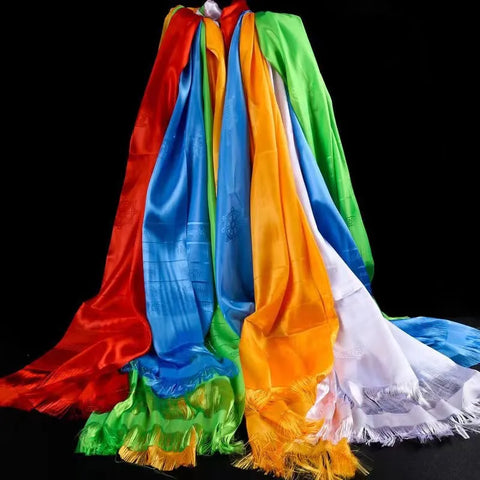
Image source: Internet
The "Monlam Dictionary" records: "There are many colors of hada, with white hada prevalent among the Tibetan people, while the Mongolian people prefer blue hada. In addition, there is a tradition that hada is used for greeting teachers, welcoming guests, funerals, weddings, and festive occasions. Originally, only white hada existed, but later blue, yellow, red, and other colored hada appeared. These are classified as Inner Treasury Hada, Outer Treasury Hada, Pure Joy Hada, and Offering Hada, etc. They are popular in the Himalayan region and Mongolia." Additionally, the "Dongga Dictionary" records: "Hada is divided into Inner Treasury Hada, East Offering Hada, and Jiaqian Hada. The so-called Inner Treasury Hada is the highest quality hada taken from the imperial treasury, with the eight auspicious symbols imprinted on it and two layers of tassels at each end; the East Offering Hada is a three zhang long special hada from the Qing Imperial family; Jiaqian Hada is shorter than Inner Treasury Hada, with only one layer of tassels at each end, and it is commonly known as Axie Hada."

Photo by Nobu Omasila
The Tibetan people have always revered the color white. White is seen as a symbol of purity, auspiciousness, loyalty, kindness, justice, and prosperity. There are two main reasons why the Tibetan people revere white. Firstly, it is related to their living environment. Secondly, it is linked to their original religion - Bon religion - and outside cultures. The Tibetan people have lived in high-altitude, cold regions with snow-capped mountains throughout history, and the presence of white snow in all four seasons has led white to symbolize purity and beauty. Additionally, the reverence for white is also influenced by Tibetan's original religion and external cultures.

Photo by Nobu Omasila
Hada also has other names, such as Lhaze (ལྷ་རྫས། sacred treasure), Lag (ལྷ་གོས། sacred clothing), Laro (ལྷ་རེག sacred touch belt), Jedar (མཇལ་དར། ceremonial silk), and Gledar (མགུལ་དར། ceremonial silk worn around the neck). In Tibetan areas, wool is abundant and people often use it as a symbol of purity on gifts exchanged between each other. For good luck and blessings, white wool is tied to the arrow shaft during the "Labzhe" ceremony, and protective talismans made of wool are tied to livestock. At celebratory feasts, a white tuft of wool is tied to the handle of the wine vessel, and a small tuft of wool is placed symbolically inside the whole roasted sheep presented to esteemed guests. Additionally, white wool is used in more formal ceremonies and rituals. This tradition continues to this day. The Tibetan people still revere the color white as auspicious. The tradition of using five-colored hada arose later. It is said that the five colors correspond to the "Five Elements," namely earth, water, fire, wind, and space.
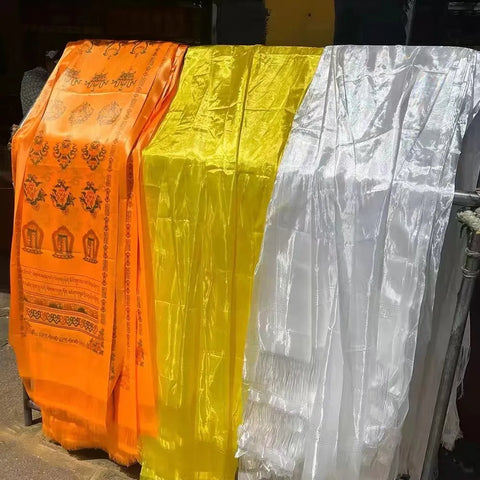
Image source: Internet
In the book "Snowy Land Holy Monk - The Life of the Great Lama Buton Rinchen Drub" by Tibetan scholar Chen Qingying, it is written that the Sakya sect was once prevalent in Tibet. Even today, the walls of common Tibetan houses in the regions of Shigatse and Dolma Lhadrang still retain the three-colored walls of the Sakya sect. The colors represent different deities: red for Manjushri Bodhisattva, white for Avalokiteshvara Bodhisattva, and blue for Vajrapani Bodhisattva, showing deep reverence for the Sakya sect. Moreover, different colors of hadas also have different meanings, such as yellow for earth, white for water, red for fire, black for wind, and blue for the sky, with black hadas being rare. Each hada has unique patterns, such as the Eight Auspicious Symbols, the Five Buddhas, and the Rainbow, and also features Tibetan words of blessings like "May all your wishes come true"(བཀྲ་ཤིས་བདེ་ལེགས།), "May all your endeavors be complete"(བཀྲ་ཤིས་བདེ་ལེགས་ཕུན་སུམ་ཚོགས།), and "Wishing you eternal happiness"(གཏན་དུ་བདེ་བ་ཐོབ་པར་ཤོག).

Image source: Internet
In terms of the types of hada, there is now a kind of wool hada made from sheep wool on the market, created by Tibetan young entrepreneur Danba Dagji. In an interview with Kangba TV's program "Chatting with Sangba", he said, "The initial decision to make this kind of pure wool hada was because the silk hada we used to use would not dissolve in seawater or melt into the earth when worshipping the sea or mountain deities, causing a great environmental hazard. However, pure wool hada can dissolve into the earth in a short time without causing environmental pollution."
Ways and Meaning of Respectful Offerings
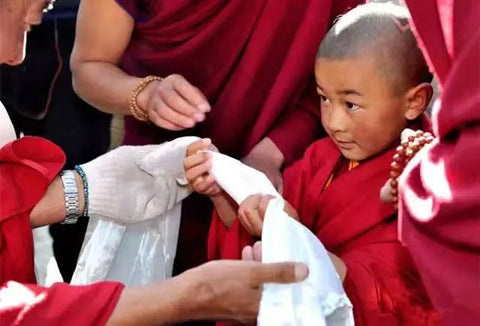
Image source: Internet
Hada is the most revered etiquette of the Tibetan people, which is an integral part of our daily lives and can be seen everywhere. Whether it is offering to Buddha statues, sutras, or stupas, or paying respects to a teacher; whether it is welcoming guests, blessing others, or paying respects to the deceased; at weddings, housewarming celebrations, and other joyful occasions, hada is always essential.
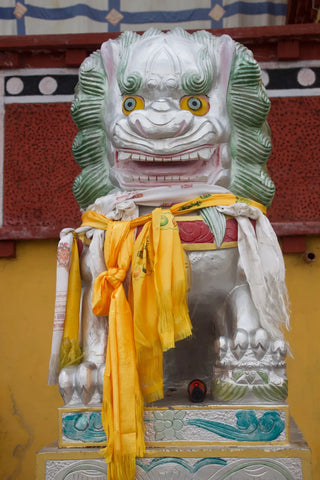
Image source: Doje Ga
There are also certain etiquettes when presenting a Hada. Professor Dequ of Qinghai Nationalities University once said, "I don't know how the current way of presenting Hada has come about. When I was young, I saw adults respectfully presenting Hada to each other, but there was never a custom of draping the Hada around the neck of the other person. Nowadays, a son-in-law can drape the Hada around the father-in-law's neck; a daughter-in-law can drape the Hada around the mother-in-law's neck; even students can drape the Hada around the teacher's neck. This behavior is disrespectful and bullying towards the other person. This behavior is not a good one and distorts the meaning of presenting Hada. Different colored Hadas have different meanings. Presenting different colored Hadas to teachers or elders has its own significance. Red and yellow are a group, dark blue and light blue are a group, and white is separate. Dark blue and light blue Hadas are to be presented to officials and dignitaries; red and yellow Hadas are to be presented to teachers. If you don't believe it, go to a temple in Lhasa and see the colors of the Hadas held by the statues. If it is a teacher, the presented Hada must not be white, but red and yellow. Hadas are categorized as Xida(ཕྱི་བཏགས), Nangda(ནང་བཏགས), and Gedda(གོས་བཏགས), while those presented between common people are known as Hada(ཁ་བཏགས)."
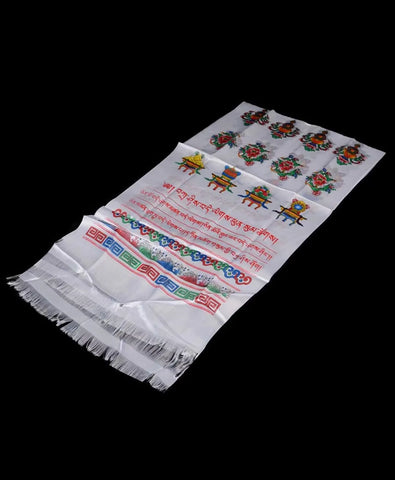
Image source: Internet
The hada nowadays are printed with various blessing words, such as "peace day and night" (ཉིན་མོ་བདེ་ལེགས་མཚན་བདེ་ལེགས), but after using them, they are used as ropes for carrying water, or to tie the mouth of a bag, completely ignoring the blessings printed on the hada. This is a very bad phenomenon. Burning the used hada in time is the best choice, using a hada symbolizing purity for housework is truly a self-deprecating behavior. As a teacher, this is the most basic common sense. Your act of offering hada today is worthy of praise. But you must understand that offering hada means handing over your sincere heart to the other person, just as when we Tibetans offer tea to guests, we extend both hands forward, palms facing up, but we have to tuck away the two thumbs because thumbs represent oneself, tucking them away signifies humility, raising both hands indicates respect for the other party, this is a very good custom. So the principle of offering hada is also the same, but nowadays few people talk about these principles, and disseminate knowledge in this area."
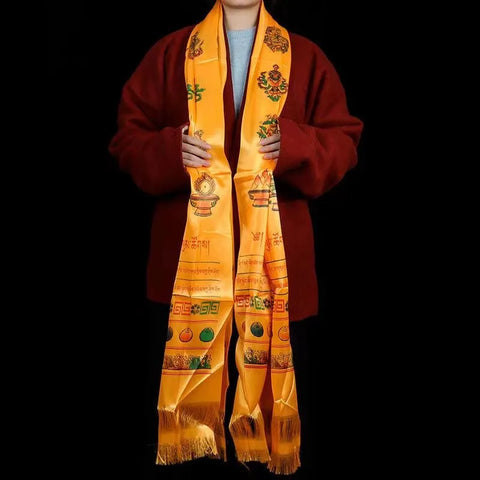
Image source: Internet
In the Tibetan writer Doje Tseden's work "The Origin of hada", it is written: "The name Hada varies according to its use.
For example, when Hada is offered as a tribute to the gods, we call it "Lhaze" (ལྷ་རྫས། treasure of the gods), "Laro" ( ལྷ་རེག heavenly belt touched by the gods), or "Lagrak" ( ལྷ་གོས། divine garment); when Hada is presented to the teacher, it is called "Jedari" ( མཇལ་དར། specially prepared silk for paying respects); for weddings and funerals, it is simply referred to as Hada or "Goladari" ( ལག་དར། silk held in the hands); when hung around the neck, it is known as "Gedari" ( མགུལ་དར། silk worn around the neck); blue and yellow Hada are commonly offered to various mountain gods and protectors by the Mongolian people; "Thangca" ( མཐིང་ཁྲ། silk with blue background and white motifs) is used in rituals and ceremonies for casting spells and performing exorcisms." As society develops, the use of Hada has become increasingly widespread, with it being used to congratulate winners at ceremonies and competitions. Additionally, in the popular Tibetan horse racing events, Hada is sometimes placed around the necks of winning horses.
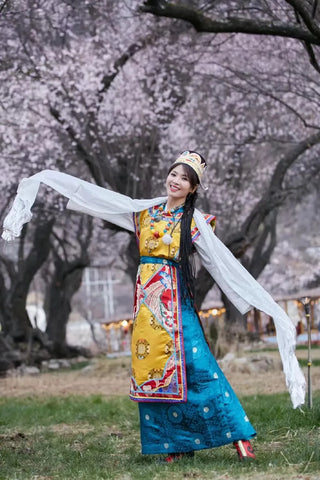
Image source: Internet
In conclusion, Hada is an essential item used by Tibetan people in their noble ceremonies, and it is an indispensable object in Tibetan life. There are different explanations for the origin of Hada, some say it originated from the white wool of the Tibetan people, while others believe it was adopted from the Mongolian culture during the Yuan Dynasty. However, I believe that the Tibetan ancestors associated the color white with purity and auspiciousness. As a result, they used white wool for all sacred and beautiful purposes, such as making talismans for livestock and wrapping it around deity arrows to signify good fortune and blessings. Therefore, I personally believe that Khata originated in Tibet.

Image source: Internet
Hada comes in various colors such as white, blue, yellow, red, etc. Originally, Hada was only white because the Tibetan people have a long-standing tradition of venerating white and prefer using white wool. White is considered a symbol of purity and nobility. However, as folk culture gradually fades, the Hada culture of the Tibetan people is also declining. Hada is now being used as an accessory for dances, shoulder straps for robes, and even belts for pants. These are issues that need to be addressed.
Furthermore, there are many customs associated with presenting Hada as a respectful gesture. For example, when presenting Hada to a lama or an official, it should be placed on a table or handed directly, never draped around the neck of the recipient. When presenting Hada to peers of equal status, it is typically placed in their open hands. If presenting Hada to juniors or those of lower status, it is placed on the gift being presented and given together. At weddings, Hada can be draped around the recipient's neck as part of the ceremony.
Respecting the customs of presenting Hada is essential, but due to a lack of understanding or knowledge, people may not follow these traditions properly. For example, students may incorrectly drape Hada around their teacher's neck, not realizing the significance. It is important to value and promote traditional Tibetan culture and heritage.
References:
1. "Monlam Dictionary" by Geshe Losang Monlam
2. "Dongga Comprehensive Dictionary" by Dongga Losang Chiqule
3. "The Origin of TuGu Religion" by Tugu Losang Qukijima
4. "Discourses with Gadang Disciples" by Adixia Zunzhe, et al.
5. "Holy Monk of the Snowy Region - Transmission of the Terton Baisiba" by Chen Qingying, translated by Gaczangda Erji
6. "The Origin of Khata" by Caidan Duoji
7. Lecture on the Cultural Significance of Khata (video) by Professor Deque from Qinghai Nationality University
8. "Chats with Xiangba" TV program, hosted by Danba Daji
9. "Khata and Tibetan Ritual Culture" by Kanben Daowei Purple Gold River Public Platform
10. "Research on the Functional Culture of Khata in Tibetan Folk Culture" by Suolangcuomu, published in Cultural Industry Bimonthly
11. "The Connotation and Others of Khata Culture" by Basang Luobu, published in Tibetan Folklore
12. "Tibetan People and Khata Culture" by Li Xueqian, published in Youth Writer, 2011 Issue 2 (second half of the month)

